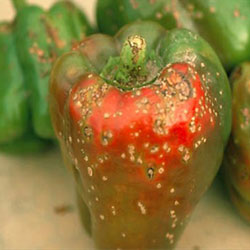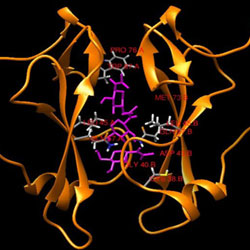Healthy Crops

The Challenge
Our world’s growing demand for higher quality food due to limited land and increased population requires more efficient crop agriculture.

Why It Is Important
Plant innate defense against fungal, bacterial, and viral pathogens is a topic of central agricultural importance because, after the physical barriers, innate defense provides the first line of protection and is responsible for activating other defense mechanisms. Additionally, reaction of the host to an invading pathogen is itself an important aspect of disease development separate from direct pathogen effects. Effector interaction with its cognate immune receptors is the first critical step in activating plant defense responses against the invading pathogen, but very little is known about the molecular details of this interaction.
Our understanding of pathogen-plant interactions has advanced significantly in recent years. Many pathogen molecules have been identified, mostly protein effectors, that facilitate success of the pathogen against the plant. Similarly, plant molecules, most termed immune receptor proteins, recognize various pathogen molecules and signal the plant’s defense system to take protective action. Researchers now have an outline of how the recognition and reaction events occur. Understanding such events on the atomic level is needed in order to create entirely new approaches to improving plant protection. To date, few molecular structures of pathogen effectors, and none of a complete immune receptor, have been obtained. This project aims to remedy this situation.
Our Approach
Our theme faculty of plant molecular biologists and protein-structure researchers is advancing the molecular biology and biochemistry of effectors and immune receptors by several parallel approaches, most importantly by obtaining 3-dimensional structures of these molecules and their complexes. There is only very limited ability to predict which specific protein will be amenable to structural analysis, and only at the end of a long series of steps does the investigator discover which protein yields a structure. These steps include molecular cloning, protein modification and production to obtain suitable amounts in solution, and function testing to determine whether the protein structure, if obtained, will have biological relevance. Protein solutions then are subjected to hundreds of trial conditions to produce protein crystals. Only some crystals are suited to structure determination by x-ray crystallography.
Impacts & Highlights
- Determined the structure for a new fungal elicitor; binding properties of three fungal elicitors were compared by numerous biological and chemical tests
- Demonstrated that fungal core effector proteins may have functions beyond suppression of host immunity and can act to adapt the fungus to varied environments
- Exploited a small lectin protein of animal origin to identify structural features; identified a subcellular binding site for which no function had been known of fungal elicitors
- Purified a few immune receptor proteins by newly developed methods that yielded highly active proteins showing extensive self-phosphorylation and trans-phosphorylation
- Applied an insect cell protein expression system to obtain large amounts of soluble immune receptor protein for crystallization; numerous attempts to produce these proteins in Escherichia coli (E. coli) or yeast were not successful
Team
| George Bruening | Professor Emeritus of Plant Pathology |
| Gitta L. Coaker | Associate Professor of Plant Pathology |
| S.P. Dinesh-Kumar | Professor of Plant Biology |
| Andrew J. Fisher | Professor of Molecular & Cellular Biology and Chemistry |
| Ioannis Stergiopoulos | Associate Professor of Plant Pathology |
| David Wilson | Professor of Molecular & Cellular Biology |
| Yi-Hsuan Chiang | Postdoc of Plant Pathology |
| Amanda Kohler | Postdoc of Plant Pathology |
| Burinrutt Thanasuwat | Junior Specialist of Plant Biology |
| Afsoon Bediei | Junior Specialist of Plant Biology |
| Anthony Salvucci | Staff Research Associate of Plant Sciences |
| George Kamita | Staff Research Associate of Entomology and Nematology |
| Nicholas Hurlburt | Graduate Student of Chemistry |
| Neeraj K. Lal | Graduate Student of Molecular & Cellular Biology |
| Donghyuk Lee | Graduate Student of Plant Pathology |
| Melissa Matthews | Graduate Student of Chemistry |
| Anna Nowak | Graduate Student of Molecular & Cellular Biology |
| Crystal Liu | Undergraduate Student of Biochemistry & Molecular Biology |
| Chie A. Ueda | Undergraduate Student of Molecular & Cellular Biology |
| Janet Tan | Undergraduate Student of Biochemistry & Molecular Biology |
| Jonghoon Chan | Undergraduate Student of Biochemistry & Molecular Biology |
| Christine Do | Undergraduate Student of Biochemistry & Molecular Biology |
| Gloria Pai | Undergraduate Student of Chemistry |
| Rosalva Flores | Undergraduate Student of Biochemistry and Molecular Biology |
| Alexander Nagourney | Undergraduate Student of Biochemistry and Molecular Biology |
| Yongam Lee | Undergraduate Student of Biochemistry and Molecular Biology |
| Gita Mallya | Undergraduate Student |
| Jesus Banderas | Undergraduate Student of Plant Pathology |
| Nicholas Fung | Undergraduate Student of Plant Pathology |
| Dean Poz | Undergraduate Student of Cell Biology |
For more information on this program, please contact Christine Parks [email protected].

